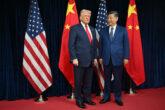
January 19, 2022
The Strategic Importance of a U.S. Digital Trade Agreement in the Indo-Pacific
Chairman Bera, Ranking Member Chabot, and the other distinguished Subcommittee Members: I appreciate this opportunity to speak with you about digital trade with the Indo-Pacific and, more broadly, the strategic importance of data rules. Thank you for your invitation.
It is a rare pleasure nowadays to deal with an issue on which there is strong bipartisan common ground. Many Democrats and Republicans in the House and Senate, including from this Subcommittee, have together urged the Biden Administration to pursue new arrangements for expanding digital trade with America’s partners in the Indo-Pacific.
I wish to stress three main points today:
First, a U.S. digital-trade agreement in the Indo-Pacific would indeed serve American interests economically and strategically.
Second, such an agreement is by no means all that is needed. Our country should improve its overall approach to digital trade – starting by curbing the massive and now unregulated flows of sensitive data from the United States to China.
Third, U.S. diplomacy should seek to cooperate with allies on both of these tracks – to expand digital trade among friends, and to limit it with China.
The Importance of Indo-Pacific Digital-Trade Expansion
The case for expanding U.S. digital trade in the Indo-Pacific is strong because digital trade is important, and the Indo-Pacific is important. The digital economy accounts for some 10% of
U.S. GDP; digital trade contributes more to U.S. GDP than financial or merchandise flows; and digital trade is growing faster than traditional trade in goods and services. The Indo-Pacific, meanwhile, is the world’s most economically and strategically important region. The United States has vital interests there, and strong allies and partners with whom we share the strategic imperative of preventing China from achieving regional hegemony.
The more that our Indo-Pacific allies and partners honor these rules, the better for regional economic development and for U.S. interests.
Increasing economic engagement with Indo-Pacific partners is a key U.S. objective. Digital trade is a ripe and valuable area to prioritize in this regard. Expanding digital-trade flows, and improving digital-trade rules, would be good for the U.S. economy, good for answering the region’s strong demand for greater U.S. economic engagement, and good for long-term U.S. strategy.
As we will surely discuss, there are various ways we could craft better digital-trade rules in the Indo-Pacific. We could build on existing arrangements, such as the 2019 U.S.-Japan Digital Trade Agreement, the digital-trade chapter of the U.S.-Mexico-Canada Agreement (USMCA), and/or the U.S.-Australia free trade agreement of 2005. We could also seek to join the evolving Digital Economic Partnership Agreement (DEPA) involving Singapore, New Zealand and Chile, and/or the Singapore-Australia digital trade agreement of 2020.
The general contours of a desirable deal are visible from previous U.S. agreements. Parties would agree not to impose tariffs on each other’s digital content. They would agree not to force technology transfer as a condition of market access (meaning companies would not be required to reveal source code or encryption keys just to participate in digital trade). Parties would agree, in general, to open cross-border data flows (meaning they would limit “data localization” rules requiring that data be stored locally and barred from transfer overseas). And parties could harmonize policies on such matters as labor rights, digital inclusion, and digital-market facilitation for small and medium-sized businesses.
The more that our Indo-Pacific allies and partners honor these rules, the better for regional economic development and for U.S. interests. That’s why there is strong bipartisanship in Congress on these issues, and on urging the Administration to prioritize digital trade and data governance in its Indo-Pacific Economic Framework.
Watch the Testimony
Read the Full Testimony
More from CNAS
-
Chinese Maker of Bitcoin-Mining Machines Is a Security Threat, Says Expert
Bloomberg News reports that a Chinese manufacturer, Bitmain Technologies Ltd, that sells most of the world’s Bitcoin-mining machines — including 16,000 of them to a venture ba...
By David Feith
-
Indo-Pacific Security / Energy, Economics & Security
North Korea’s Provocations, Power Plays, and Shifting AlliancesTensions on the Korean Peninsula have reached a new and dangerous threshold. President Lee Jae Myung is warning of a real risk of accidental military clashes, as the situation...
By Dr. Go Myong-Hyun
-
Indo-Pacific Security / Energy, Economics & Security
How to Win the Economic War with ChinaTrump's approach to China has run aground, giving Beijing unprecedented advantage in the economic conflict....
By Edward Fishman & Julian Gewirtz
-
Indo-Pacific Security / Technology & National Security
Sharper: Tech + ChinaRecent talks between President Donald Trump and Chinese Communist Party General Secretary Xi Jinping placed a spotlight on emerging technologies, from high-end chips to minera...
By Charles Horn & Sevi Silvia




